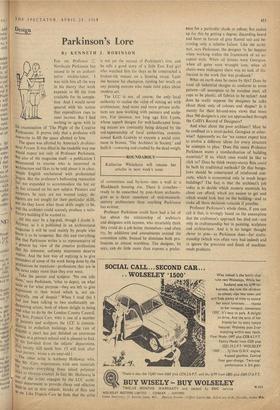Parkinson's Lore
By KENNETH J. ROBINSON The space was allotted by America's Architec- tural Forum. It was filled in the readable way one would expect not only of Professor Parkinson. but also of the magazine itself—a publication I recommend to anyone who is interested in architecture and likes to be told about it in clear, IniPle English uncluttered with professional Jargon. But the professor's ballooning reputation has not expanded to accommodate the hot air he has re:eased on his new subject. Painters and 'culptors, he says, are not wanted today; de- 4ners are not sought for their particular skills, nor do they know what those skills ought to be, and the architect could scarcely produce a satis- factory building if he wanted to.
All this may be a leg-pull, though I doubt it. Anyway, as it is published in an architectural Hiagazine it will be read mainly by people who know it to be nonsense. But this and everything else that Parkinson writes is so representative of a general lay view of the creative professions that his tiresome, unfunny statements deserve replies. And the best way of replying is to give reminders of some of the work being done by the Professions he mentions—professions that are in the news today more than they ever were. Take the painter and sculptor. 'No one tells them,' says Parkinson, 'what to depict, on what scale or for what purpose—they are left to give expression to their mood which is, not un- naturally, one of despair.' When I read this I had just been talking to two exuberantly un- despairing artists, both of whom delight in being told what to do by the London County Council. rhe first, Francis Carr, who is one of a number (),f painters and sculptors the LCC is commis- 111"ing to embellish buildings (at the rate of `000 a year) has just finished an enormous Osaic in a primary school and is pleased to find, 11 his fan-mail from the infants' department, that society still needs him. ('I will look after picture,' wrote a six-year-old.) he other artist is Anthony Hollaway who, 1. lits Mr. Carr, experiments with new materials '7. murals—everything from inlaid polyester No to vitreous enamel. In fact Mr. Hollaway is one of the artists engaged by the LCC archi- tects' department to provide cheap and effective built-in art in new schools, blocks of flats and 40 on. Like Francis Carr he finds that the artist is not yet the outcast of Parkinson's lore, and he tells a good story of a little East End girl who watched him for days as he constructed a broken-tile mosaic on a housing estate. Later she became his champion, turning her wrath on any passing morons who made mild jokes about modern art.
The LCC is not, of course, the only local authority to realise the value of mixing art with architecture. And more and more private archi- tects are now working with painters and sculp- tors. For instance, not long ago Eric Lyons, whose superb designs for well-landscaped hous- ing estates are constantly being delayed by the red-tapemanship of local authorities, commis- sioned Keith Godwin to execute a social com- ment in bronze, 'The Architect in Society,' and built it—cowering and crushed by the dead weight ROUNDABOUT Katharine Whitehorn will resume her articles in next week's issue.
of committees and by-laws--into a wall at a Blackheath housing site. There it crouches— ready to be unearthed by post-Atom archaeolo- gists as a fairer statement of mid-twentieth- century architecture than anything Parkinson has written.
Professor Parkinson could have had a lot of fun about the relationship of architects and designers with laymen, who invariably think they could do a job better themselves—and often try, by additions and amendments around the committee table. Instead he dismisses both pro- fessions as almost worthless. The designer, he says, can do little more than express a prefer- ence for a particular shade or colour, but makes up for this by getting a degree, discarding beard and beret in favour of grey flannel suit and be- coming only a relative failure. Like the archi- tect, says Parkinson, the designer 'is far happier when working within the framework of an ac- cepted style. When all houses were Georgian, when all gates were wrought iron, when all chairs were mahogany there was no lack of dis- tinction in the work that was produced.'
What on earth does he mean by this? Does he want all industrial designs to conform to some pattern—all saucepans to be stainless steel, all cups to be plastic, all fabrics to be nylon? And does he really suppose the designers he talks about think only of colours and shapes? Is it merely for their hit-and-miss views that more than 500 designers a year are approached through the ColD's Record of Designers?
And what about the poor architect? Must he be confined to a strait-jacket, Georgian or other- wise? Apparently so, for 'we cannot expect him to evolve a different idiom for every structure he attempts to plan.' Does this mean Professor Parkinson wants a standardisation of building materials? If so, which ones would he like to stick to? Does he think twenty-storey flats could be built by traditional methods? Or that bunga- lows should be constructed of reinforced con- crete, which is economical only in much larger buildings? The fact is that the architect's job today is to decide which modern materials his client can afford, which are easiest to get and which would look best on the building—and to make all three decisions coincide if, possible.
Professor Parkinson's whole thesis, if you can call it that, is wrongly based on the assumption that the craftsman's approach has died out—not only in craftsmanship but in painting, sculpture and architecture. And it is no longer thought clever to pine—as Parkinson does—for crafts- manship (which was often very bad indeed) and to ignore the precision and finish of machine- made products.














































 Previous page
Previous page